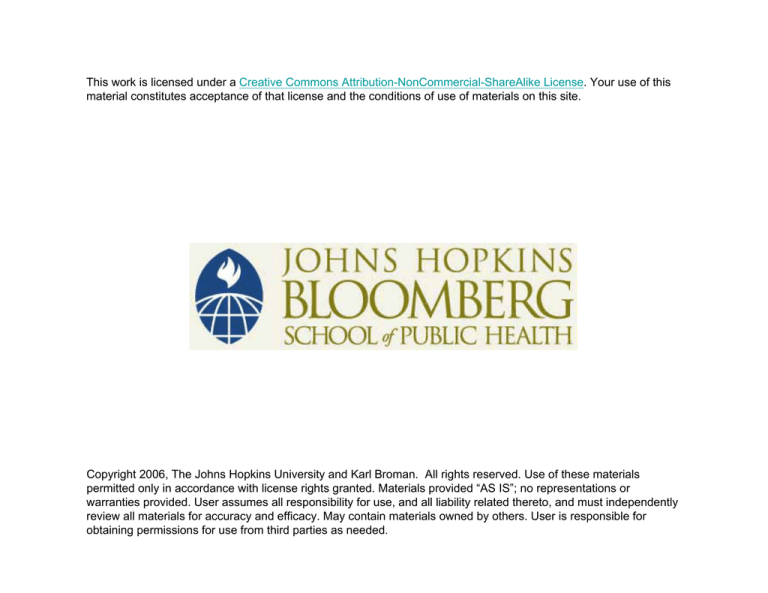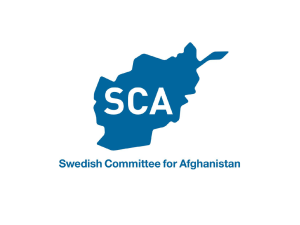
This work is licensed under a Creative Commons Attribution-NonCommercial-ShareAlike License. Your use of this
material constitutes acceptance of that license and the conditions of use of materials on this site.
Copyright 2006, The Johns Hopkins University and Karl Broman. All rights reserved. Use of these materials
permitted only in accordance with license rights granted. Materials provided “AS IS”; no representations or
warranties provided. User assumes all responsibility for use, and all liability related thereto, and must independently
review all materials for accuracy and efficacy. May contain materials owned by others. User is responsible for
obtaining permissions for use from third parties as needed.
Solutions for homework for lecture 6
Page 1 of 3
Statistics for laboratory scientists
Solutions for the homework problems for lecture
6
1.
a. Suppose that A and B are mutually exclusive.
i. Pr(A or B) = Pr(A) + Pr(B)
ii. Pr(A and B) = 0, since they can't both happen.
b. Suppose that A and B are independent.
i. Pr(A and B) = Pr(A) × Pr(B)
ii. Pr(A or B) = Pr(A) + Pr(B) - Pr(A) × Pr(B)
c. Suppose that A and B are both mutually exclusive and
independent.
Since A and B are independent, Pr(A and B) = Pr(A) × Pr(B).
But since A and B are mutually exclusive, Pr(A and B) = 0. Thus
Pr(A) × Pr(B) = 0. And so either Pr(A) = 0 or Pr(B) = 0 or both.
In other words, either A or B (or both) cannot happen!
The point: generally when we talk about independent events,
they are not mutually exclusive, and vice versa.
2. Recall that we pick a woman at random from the population. Let U =
{She is unaffected}, C = {She is a carrier}, A = {her brother is
affected and her parents are both unaffected}, B = {her first child is
affected}, D = {at least one of her five children is affected}. Note
that by "carrier," I mean "has genotype +d."
Calculate the following.
a. Pr(C | U) = 2p(1-p) / [2p(1-p) + (1-p)2] = ... = 2p / (1 + p) =
approx 2.0%.
b. Pr(C | U and A) = 2/3 = approx 67%, since her parents must
both be carriers.
http://www.biostat.jhsph.edu/~kbroman/teaching/labstat/third/soln06.html
3/31/2006
Solutions for homework for lecture 6
Page 2 of 3
c. Pr(B | U and A) = Pr(C | U and A) × Pr(B | C and U and A) =
(2/3) × [(1/2) × p] = p/3 = approx 3/1000.
Note that Pr(B | C and U and A) = Pr(B | C). We're assuming
here that the woman is mating at random (with respect to
genotype at this gene). Thus the allele contributed by the father
has probability p of being the disease allele.
d. Let E = {none of the five children is affected}, F0 = {father has
genotype ++}, F1 = {father has genotype +d}, and F2 =
{father has genotype ++}.
Note that Pr(E | C) = Pr(F0) × Pr(E | C and F0) + Pr(F1) × Pr(E |
C and F1) + Pr(F2) × Pr(E | C and F2)
= (1-p)2 × 1 + 2 p (1-p) × (3/4)5 + p2 × (1/2)5 = approx
98.5%.
Thus, Pr(D | U and A) = Pr(C | U and A) × Pr(D | C and U and
A)
= Pr(C | U and A) × [1 - Pr(E | C)]
= approx 1%.
3.
a. Pr(G1) = Pr(A) × Pr(G1 | A) + Pr(B) × Pr(G1 | B) = (1/3) ×
(1/2) + (2/3) × (1/5) = 3/10 = 30%
b. Pr(G2 | A and G1) = 4/9
c. Pr(G2 | A) = 1/2
d. Pr(G2 | B and G1) = 1/9
e. Pr(G2 | G1) = Pr(G2 and G1) / Pr(G1)
Note that Pr(G2 and G1) = Pr(A) × Pr(G1 and G2 | A) + Pr(B) ×
Pr(G1 and G2 | B) = (1/3) × (5/10) × (4/9) + (2/3) × (2/10) ×
(1/9) = 4/45 = approx 8.9%
We found that Pr(G1) = 3/10 (part a).
http://www.biostat.jhsph.edu/~kbroman/teaching/labstat/third/soln06.html
3/31/2006
Solutions for homework for lecture 6
Page 3 of 3
Thus, Pr(G2 | G1) = (4/45) / (3/10) = 8/27 = approx 30%
f. Pr(exactly one green ball) = Pr(G1 and not G2) + Pr(G2 and not
G1) = 2 × Pr(G1 and not G2) = 2 × [Pr(A) × Pr(G1 and not G2)
+ Pr(B) × Pr(G1 and not G2)] = 2 × [(1/3) × (5/10) × (5/9) +
(2/3) × (2/10) × (8/9)] = 114/270 = approx 42%.
g. Note that Pr(at least one green ball | A) = 1 - Pr(no green balls
| A) = 1 - (1/2) × (4/9) = 7/9 = approx 78%. Pr(at least one
green ball | B) = 1 - (4/5) × (7/9) = 17/45 = approx 38%.
Thus Pr(at least one green ball) = (1/3) × (7/9) + (2/3) ×
(17/45) = approx 51%.
And so Pr(A | at least one green ball) = Pr (A) × Pr(at least one
green ball | A) / Pr(at least one green ball) = (1/3) × (7/9) /
[(1/3) × (7/9) + (2/3) × (17/45)] = approx 51%.
4. Let F = {the champion is the colt's father} and C = {the colt carries
the Y marker}.
a. Pr(F) = 1/2.
b. Pr(F | C) = Pr(F) Pr(C|F) / [Pr(F) Pr(C|F) + Pr(not F) Pr(C | not
F)] = (1/2) × (1) / [(1/2) × 1 + (1/2) × 0.02] = approx 98%.
c. Given that the mare was exposed to a total of 1000 stallions, we
have Pr(F) = 1/1000. Thus Pr(F | C) = Pr(F) Pr(C|F) / [Pr(F) Pr
(C|F) + Pr(not F) Pr(C | not F)] = (1/1000) × (1) / [(1/1000) ×
1 + (999/1000) × 0.02] = approx 4.8%.
[ 3rd term syllabus | 4rd term syllabus | R for
Windows ]
Last modified: Wed Feb 22 09:44:30
EST 2006
http://www.biostat.jhsph.edu/~kbroman/teaching/labstat/third/soln06.html
3/31/2006







